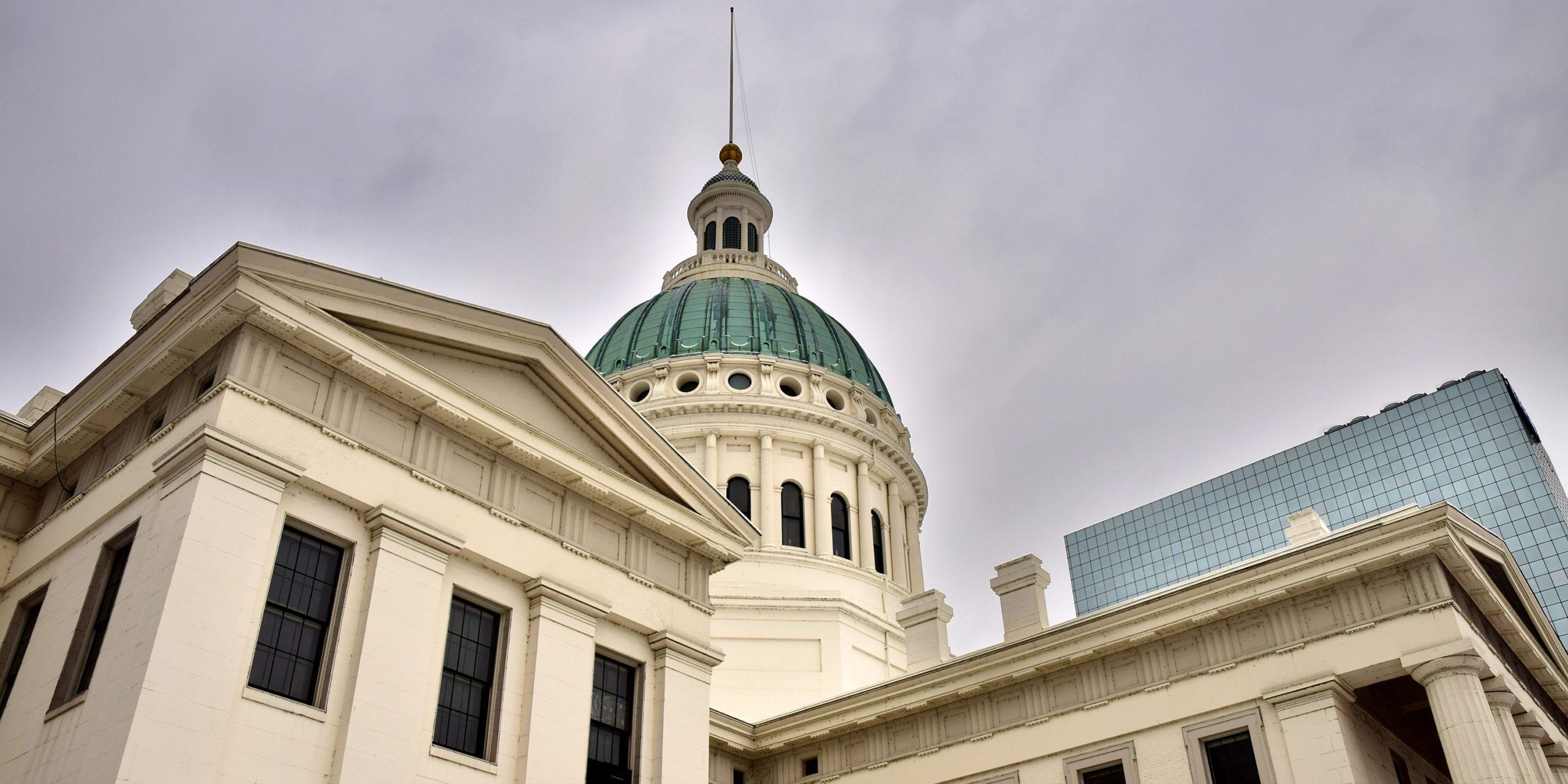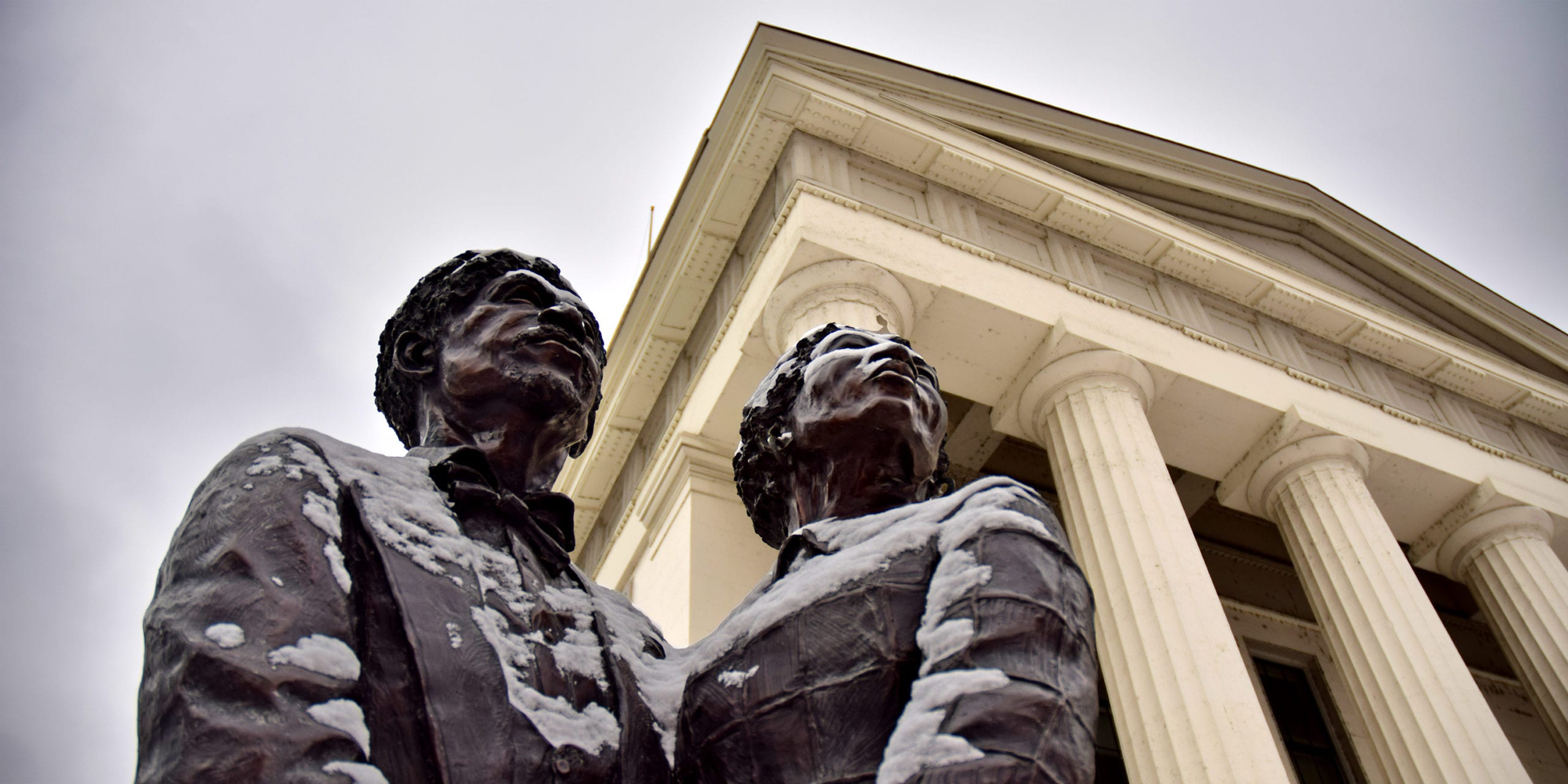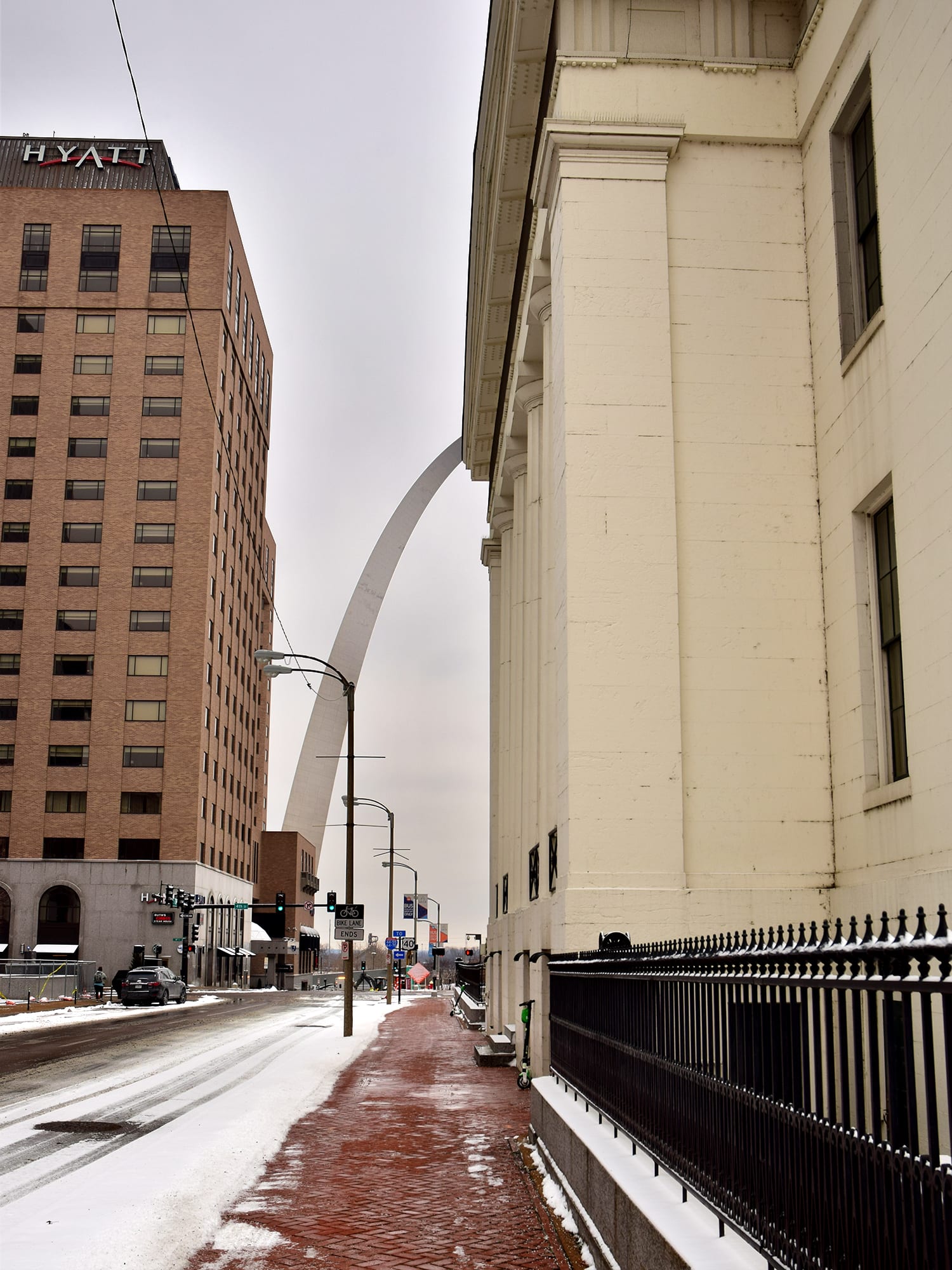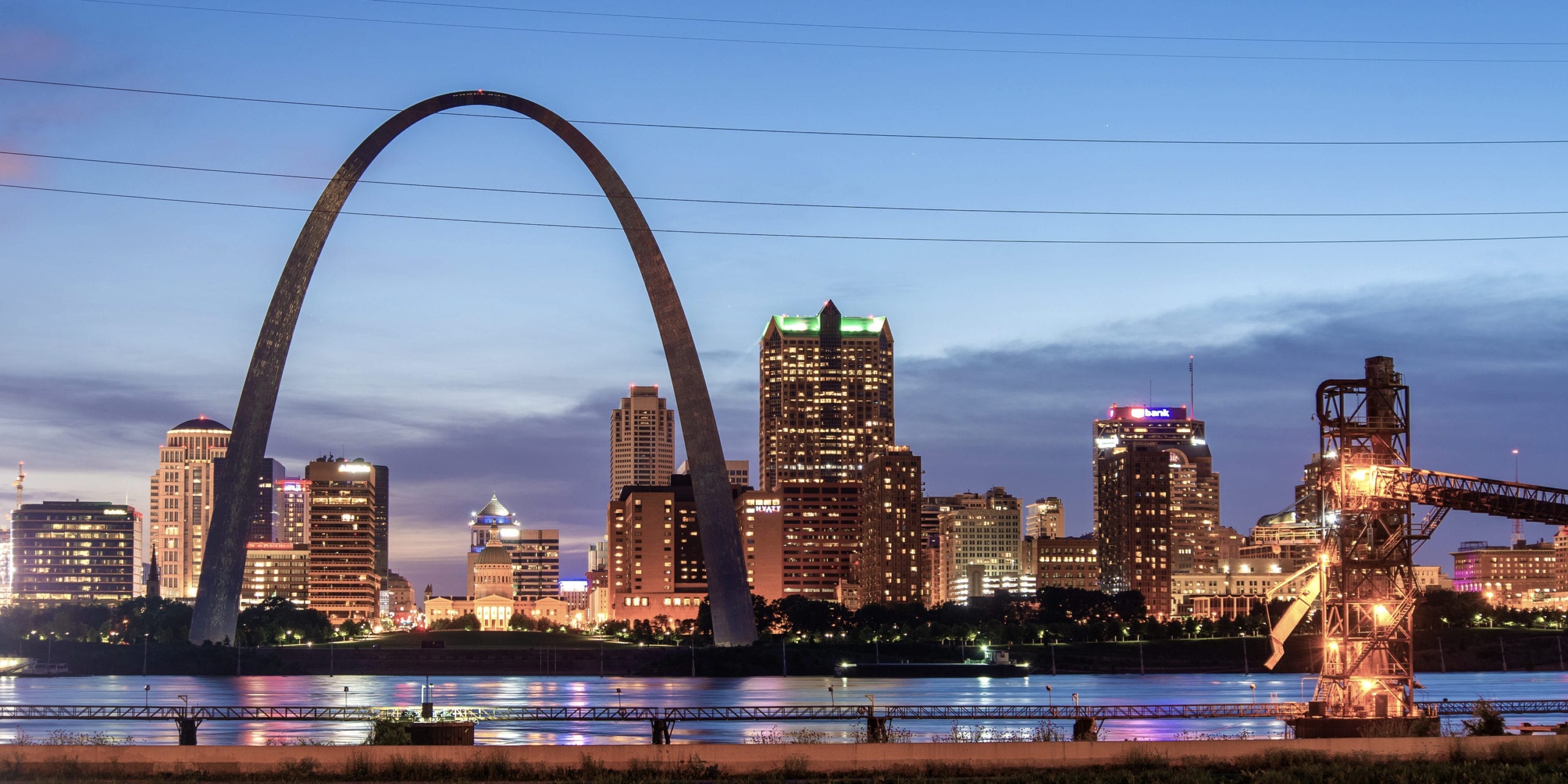
The Old Courthouse in downtown St. Louis is getting an update as part of a $380 million revitalization of the grounds of Gateway Arch National Park. An iconic element of the St. Louis skyline, the first iteration of the Old Courthouse was completed in 1828, with various upgrades and expansions occurring over the next decades. The distinct iron and copper dome was completed in 1864.
While many in St. Louis might have intimate knowledge of the history of the Old Courthouse, most visitors to St. Louis and those living outside the region are likely unaware of why the courthouse is a historic federal building. Aside from its famous silhouette below the Gateway Arch, the Old Courthouse is best known for its role in the Dred Scott case, in which an enslaved Black man sued for his freedom. The case marked the end of an era in which hundreds of slaves sued for their freedom in St. Louis and stoked the tensions that led to the Civil War.
Once Free, Always Free: The History of Freedom Suits in St. Louis
In 1807, the Missouri Territory enabled a statute that permitted any person wrongly held in slavery to sue for their freedom. Such suits were referred to as “freedom suits.” Each suit required a charge of trespass of false imprisonment and witness testimony. The process was cumbersome, as the person who brought suit had the burden of proving that they were in fact free, and that their captor had inflicted physical abuse upon them. Furthermore, most would-be petitioners lacked the ability to read or write, not to mention the resources needed to seek counsel. Many cases were handled pro bono by abolitionist attorneys in the community.
The Missouri Supreme Court interpreted the territorial statute in 1824 and formally established Missouri’s criteria for a freedom suit. The precedent, set in Winny v. Whitesides, was known as “once free, always free.”
Winny was an enslaved woman owned by Phoebe Whitesides. Whitesides kept Winny as a slave while living in Illinois for a number of years. Winny won her case before the Circuit Court and prevailed again after Whitesides appealed the case to the Missouri Supreme Court. The Supreme Court heard that appeal at the Old Courthouse. On the appeal, the Supreme Court affirmed that a slave taken to a state or territory which had outlawed slavery, by virtue of being in a free land, became a free person. The freedom held even if a former slave returned to a slave state like Missouri. That freedom could not be revoked.
The Winny v. Whitesides decision ushered in a “golden age” of freedom suits. Approximately 300 freedom suits were brought before the Circuit Court in St. Louis throughout the middle of the 19th century. More than half of the petitioners prevailed in their fight for freedom under the “once free, always free” doctrine.

The Dred Scott Freedom Suit
The Old Courthouse was the site of the trial level freedom suits of Dred Scott and his wife Harriet in 1847 and 1850. When most hear Dred Scott, they jump to the infamous 1857 Supreme Court opinion in Dred Scott v. Sandford that held, “it is too clear for dispute that the enslaved African race were not intended to be included, and formed no part of the people who framed and adopted” the Declaration of Independence. The Supreme Court decided that Black people, whether free or enslaved, were not entitled to the privileges enshrined to American citizens in the Constitution.
Victory in St. Louis
However, the road to the Supreme Court case was a complicated one. Spanning more than a decade of litigation, the Dred Scott case started in St. Louis at the Old Courthouse. The Scotts’ original petition for freedom claimed that they had resided in the free state of Illinois at Rock Island and in the free Wisconsin Territory at Fort Snelling. Because they had been voluntarily held by their owner in these locations where slavery was not permitted, they argued that they were entitled to freedom. The Missouri Circuit Court in St. Louis agreed in 1850.
Appeal to the Missouri Supreme Court
The Scotts’ alleged owners appealed the case to the Missouri Supreme Court, and the parties again pleaded their cases at the Old Courthouse in downtown St. Louis. The tides had shifted at the high court since the days of “once free, always free,” and the Missouri Supreme Court overturned the Scotts’ victory in the lower court. The court sought to strengthen its position on states’ rights, stating in 1852, “Times are not now as they were when the former decisions on this subject were made. Since then, not only individuals but States have been possessed with a dark and fell spirit in relation to slavery.” In other words, just because you were free in Illinois, you are not guaranteed freedom in Missouri.
The Federal Suit
After the loss, the Scotts again sued for their liberty in 1853, but this time at the federal level. The federal court had jurisdiction as the Scotts’ so-called owner was residing in New York. However, the court instructed jurors to rely on Missouri law when determining whether or not the Scotts should be free. In light of the recent decision of the Missouri Supreme Court, the Scotts were again denied their freedom. They appealed to the U.S. Supreme Court.
The Supreme Court’s Dred Scott Decision
The Dred Scott opinion is remembered as one of the darkest moments of jurisprudence in our nation. The majority chose to ignore the expansive ideals of the Constitution, the Declaration of Independence, and our nation in favor of an inhumane and antiquated interpretation of the founders’ intentions.
The opinion was delivered by Chief Justice Roger Taney, a slave owner and southern sympathizer who outspokenly supported the institution of slavery. At the time, the Supreme Court included four southern justices. Behind the scenes, President-elect James Buchanan pressured northern justices to join the majority, hoping to put an end to the slavery question. Ultimately the efforts resulted in a 7–2 ruling against the Scotts. The decision outraged the growing contingent of anti-slavery Americans and pushed the nation closer to civil war.
The Old Courthouse’s Legacy in Civil Rights History
As we have seen here, the Old Courthouse was the stage for early decisive victories for slaves seeking freedom. The Old Courthouse also served as a setting for decisions that reversed those victories and diminished the possibility for former slaves to be guaranteed liberty. Missouri was always viewed as a divided state, and the wild swings in the opinions of the courts over just a handful of decades puts those divisions into stark relief. Soon after the Missouri Supreme Court’s ruling against Dred and Harriet Scott, the state would send thousands of soldiers to serve both the Union and Confederate armies.
While the Scotts did not ultimately prevail in their fight for freedom, their cases helped to fuel abolitionist movements and provided context to the struggle for Black freedom that has existed since the birth of our nation. A solid majority of the U.S. Supreme Court at the time of the Scott decision believed that the founding fathers saw Blacks as “so far below them in the scale of created beings” that the Constitution couldn’t possibly apply to Blacks enslaved or free. That such unconscionable beliefs were widely held, accepted, and enshrined into law shows the strength of the institutions which slaves, freed Blacks, and abolitionists had to push back against. While the 13th Amendment abolished slavery, the fight for Black civil rights continues. The relentless spirit of Dred and Harriet Scott in their pursuit of liberty lives on.
The Old Courthouse Today
Gateway Arch National Park serves as a “memorial to Thomas Jefferson’s role in opening the West, to the pioneers who helped shape its history, and to Dred Scott who sued for his freedom in the Old Courthouse.” The park, previously known as the Jefferson National Expansion Memorial, was renamed in 2018. As part of a massive project to update the park, a bridge and a small park space were built to provide a direct connection between the Arch and the Old Courthouse.
The final piece of the update project, known as CityArchRiver, is a full renovation of the Old Courthouse. Beginning in late 2021, the renovation will include upgrades to mechanical systems and accessibility improvements along with new exhibit galleries. The new northeast gallery will focus entirely on the Dred Scott case. The northwest gallery will examine Black life in St. Louis during the time of slavery, and the battles for freedom which were frequently fought in the Old Courthouse’s courtrooms.
A bronze statue of Dred and Harriet Scott stands in the southeast courtyard of the Old Courthouse. The statue was unveiled in 2012 and erected through the work of the Dred Scott Heritage Foundation.


In the Shadow of the Old Courthouse
Rasmussen Dickey Moore’s St. Louis office is located directly south of the historic Old Courthouse. The landmark serves as a daily reminder of the importance of the pursuit for justice: “Equality for all under the law without bias, or prejudice of any kind.” Moreover, we are reminded of the ongoing struggle for equality that Blacks and other minorities face both in the world at large and in the legal industry specifically.
RDM is committed to facing these challenges and building a diverse, equitable, and inclusive firm culture where attorneys and staff of all backgrounds can succeed, and we strive to be leaders when it comes to addressing diversity issues in small and mid-sized law firms. The reflection of the Old Courthouse on the walls of our building is an admonishment to build a better future for our attorneys, staff, and clients.


